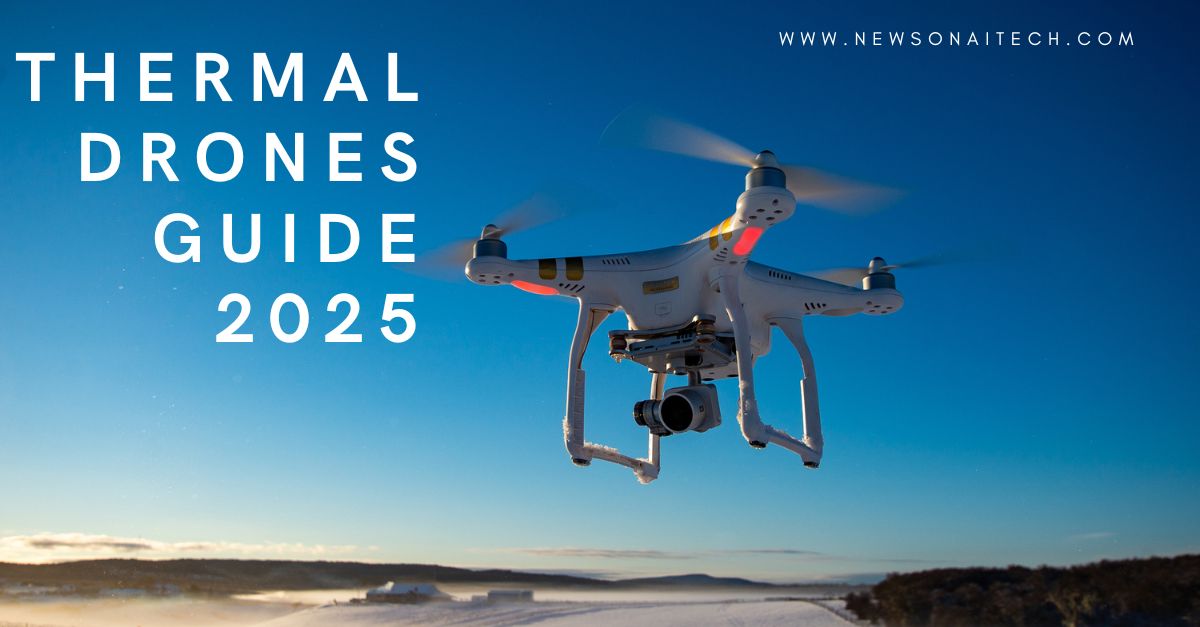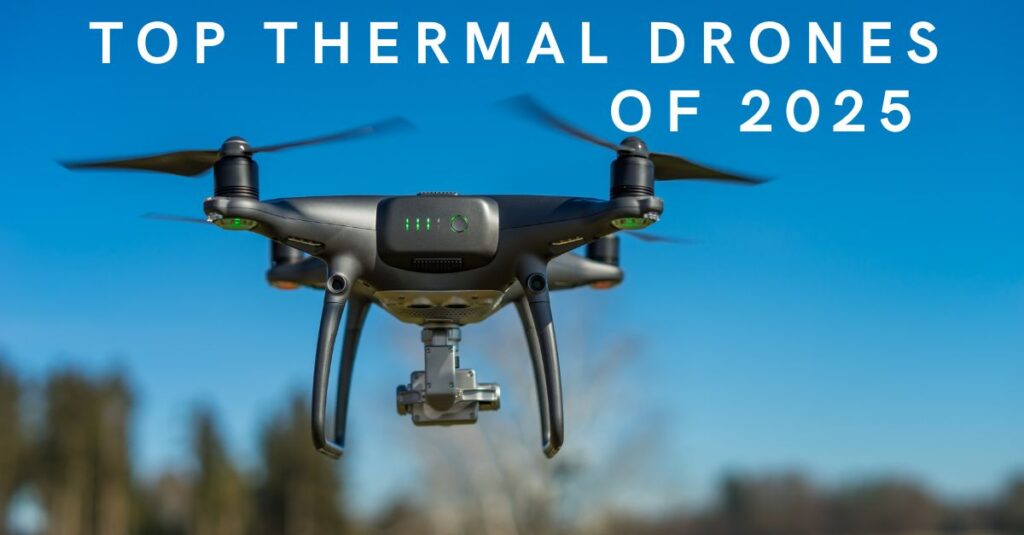Thermal Drones Guide 2025: Top Models, Tech & Features

Beyond the visible spectrum lies a world of thermal energy, and advanced thermal drones are the key to accessing it. These sophisticated aircraft use infrared sensors to visualize heat signatures, creating a detailed picture of temperature differences invisible to the naked eye.
This capability is revolutionizing operations across dozens of industries, from locating missing persons in the dark to identifying failing components on critical infrastructure.
This article, Thermal Drones: Your Complete Expert Guide, will navigate the essentials of this powerful technology.
We will explore how these systems function, their most impactful applications, the key features to analyze before a purchase, and the financial considerations involved in adopting this game-changing equipment.
Top Thermal Drones of 2025: Best Models, Uses & Buyer’s Guide
The 2025 market features a range of thermal drones designed for diverse professional needs. Below, we highlight the leading models, their specifications, and what makes each stand out.

1. DJI Mavic 3T – Best All-Around Thermal Drone
- Thermal Sensor: 640 x 512 px (radiometric)
- Visual Camera: 48MP wide + 12MP hybrid zoom (56x)
- Flight Time: Up to 45 min
- Range: 15 km
- Weight: 920g
Key Features:
Combines high-performance thermal and visual imaging, full obstacle avoidance, and real-time analytics. Ideal for fire departments, building inspectors, and law enforcement.
Pros:
- Exceptional image quality and analytics
- Long flight time
- Comprehensive obstacle avoidance
Cons:
- No internal storage
- MicroSD access can be awkward2
2. Autel EVO Max 4T – High-Performance, Anti-Jamming Drone
- Thermal Sensor: FLIR Boson 640 x 512 px
- Visual Sensor: 4000 x 3000 px
- Flight Time: 42 min
- Range: 20 km
- Weight: 1.62 kg
Key Features:
Bright touchscreen controller, anti-interference shielding, and powerful 3D mapping tools. Designed for civil engineering, telecom, and tactical government use.
Pros:
- Advanced mapping and anti-jamming
- Omnidirectional obstacle sensors
- Bright, user-friendly controller
Cons:
- Steeper learning curve for beginners
- Expensive spare batteries
3. Parrot Anafi USA – Lightweight, Secure Government-Grade Drone
- Thermal Sensor: FLIR Boson 320 x 256 px
- Visual Camera: Dual 21MP with 32x zoom
- Flight Time: 32 min
- Weight: 499g
Key Features:
Blue UAS-approved for government use, encrypted video stream, and near-silent operation. Perfect for urban surveillance and field operatives.
Pros:
- Lightweight and portable
- High security with encrypted streams
- Quiet operation
Cons:
- Lower thermal resolution compared to competitors
4. DJI Matrice 30T – Rugged Enterprise Thermal Drone
- Thermal Sensor: 640 x 512 px radiometric
- Visual: Zoom (200x hybrid), wide, laser rangefinder
- Flight Time: 41 min
- Weight: 3.7 kg
Key Features:
IP55 water/dust resistance, all-weather performance, and compatibility with autonomous recharging stations. Suited for emergency services and disaster recovery.
Pros:
- Built for extreme conditions
- Autonomous docking compatibility
- Military-grade reliability
Cons:
- Expensive
- Overkill for light tasks
5. Teledyne FLIR SIRAS – Precision Thermal Analysis
- Thermal Camera: FLIR 640 x 512 px radiometric
- Visual Sensor: 16MP stabilized
- Flight Time: 31 min
- Weight: 1.5 kg
Key Features:
Engineered for thermography professionals, offers pure thermal accuracy and full data privacy (no cloud streaming).
Pros:
- High thermal analysis accuracy
- Simple user experience
- Full data privacy
Cons:
- Shorter range
- Fewer third-party integrations
How Do Thermal Drones Work?
A thermal drone, also known as a thermal imaging UAV (Unmanned Aerial Vehicle), operates on the principle of detecting infrared radiation. Every object with a temperature above absolute zero emits thermal energy.
While the human eye perceives visible light, a thermal camera is equipped with a specialized sensor, called a microbolometer, that detects variations in this infrared energy.
When the drone is in flight, its thermal camera captures the infrared radiation from the objects and terrain below. The microbolometer measures the temperature of thousands of individual points within its field of view.
This data is then processed by the drone’s internal software, which assigns a specific color to each temperature value, creating a visual heat map called a thermogram. Colder areas might be represented by blue or purple, while warmer areas appear as red, orange, or yellow.
This allows the operator to instantly identify anomalies, such as a person’s body heat against cool ground, an overheating electrical component, or a water leak beneath a roof.
The drone platform itself provides the mobility, stability, and range needed to deploy this sensor in hard-to-reach or hazardous locations, making the combination of flight and thermal imaging a uniquely powerful tool.
Core Applications: Where Thermal Drones Excel
The ability to see heat signatures has created immense value and efficiency in numerous sectors. By providing a perspective that was previously impossible or extremely costly to obtain, thermal drones are enhancing safety, saving money, and delivering critical data.
1. Public Safety and Search & Rescue
In emergency services, time is a critical factor. Thermal drones provide a significant advantage by allowing teams to scan large areas quickly, even in complete darkness, fog, or smoke.
Search and Rescue (SAR): Operators can locate missing persons or hikers by detecting their body heat against the cooler temperature of the surrounding environment, drastically reducing search times in forests, mountains, or disaster zones.
Firefighting: Fire departments use thermal drones to identify hotspots within a burning structure, locate trapped individuals, and monitor the fire’s progression from a safe distance. This situational awareness is vital for deploying resources effectively and keeping firefighters safe.
Law Enforcement: Police can use thermal imaging for fugitive searches at night, accident scene investigation, and surveillance operations without revealing their position.
2. Industrial and Infrastructure Inspection
Maintaining vast networks of infrastructure is a costly and often dangerous task. Thermal drones make these inspections faster, safer, and more accurate by identifying problems before they lead to catastrophic failures.
Energy and Utilities: Drones can inspect miles of power lines to find overheating connections or faulty transformers. They are also used to inspect solar farms, quickly identifying defective panels that are not performing at optimal capacity.
Building and Roofing: A thermal scan of a commercial roof can pinpoint areas of water intrusion and poor insulation that are invisible to the naked eye, preventing long-term structural damage.
Oil and Gas: Thermal drones are used to inspect pipelines, storage tanks, and flare stacks, detecting leaks and structural weaknesses without shutting down operations or putting personnel at risk.
3. Agriculture and Environmental Monitoring
Precision agriculture relies on data to optimize crop yield and resource management. Thermal drones provide a unique layer of information for farmers and environmental scientists.
Irrigation Management: By analyzing the temperature of the plant canopy, farmers can identify areas of water stress and adjust irrigation systems accordingly, conserving water and improving crop health.
Animal Health: Ranchers can use thermal drones to locate livestock over large pastures and even detect signs of fever or illness in individual animals.
Wildlife Conservation: Researchers monitor animal populations, track poachers at night, and study animal behavior without disturbing their natural habitats.
4. Security and Surveillance
For securing large perimeters like industrial plants, data centers, or private estates, thermal drones offer a persistent surveillance advantage, especially after dark.
Perimeter Security: A thermal drone can autonomously patrol a fence line, instantly detecting intruders by their heat signature long before they reach a sensitive area.
Event Monitoring: Security teams at large public events can use a thermal drone to monitor crowds and identify potential threats from an aerial vantage point.
Key Features to Analyze in a Thermal Drone
Selecting the right thermal drone depends entirely on its intended application. Evaluating the technical specifications of the thermal sensor and the drone platform is essential for ensuring it will perform as needed. Consider the following core features before making a decision.
Thermal Sensor Resolution: This is one of the most important specifications, measured in pixels (e.g., 320×256 or 640×512). A higher resolution means more pixels on the target, resulting in a clearer, more detailed thermal image that allows you to identify smaller anomalies from a greater distance.
Thermal Sensitivity (NETD): Noise Equivalent Temperature Difference (NETD), measured in millikelvins (mK), indicates the smallest temperature difference the sensor can detect. A lower NETD value (e.g., <50mK) means the sensor is more sensitive and will produce a higher-quality image, especially in situations with subtle temperature variations.
Radiometric Data: A radiometric thermal camera doesn’t just show a heat picture; it embeds precise temperature data into every pixel of the image. This allows you to use software to measure the temperature of any point on the image, which is vital for quantitative inspections like checking electrical components.
Dual Camera System: Many professional thermal drones include both a thermal sensor and a high-resolution visual (RGB) camera. This allows the operator to switch between views or see them side-by-side, making it much easier to contextualize where a thermal anomaly is located.
Flight Time and Range: The drone’s battery life and control range determine how large an area you can cover in a single flight. For large-scale inspections or search and rescue missions, longer flight times (30+ minutes) are a necessity.
The Pros and Cons of Using Thermal Drones
While incredibly powerful, thermal imaging technology has its own set of advantages and limitations. A balanced view is necessary for any organization considering integrating these systems into their workflow. Here is a breakdown of the primary pros and cons.
Pros
Operation in Any Light Condition: Since they detect heat instead of light, thermal drones function just as effectively in complete darkness as they do during the day, making them ideal for 24/7 operations.
Rapid Anomaly Detection: They excel at quickly highlighting temperature differences, making it easy to spot issues like overheating machinery, insulation gaps, or a person hidden in foliage.
Enhanced Safety: Drones allow operators to inspect dangerous or inaccessible areas (e.g., cell towers, flare stacks, disaster sites) from a safe distance, removing personnel from harm’s way.
Non-Invasive and Non-Destructive: Thermal inspections can be conducted without shutting down equipment or physically altering the asset being inspected, saving time and money.
Cons
High Initial Cost: Professional-grade thermal drones represent a significant investment, often costing many thousands of dollars more than standard visual drones.
Weather Limitations: Performance can be negatively impacted by environmental conditions. Heavy rain, dense fog, and even high humidity can obscure thermal readings and reduce effectiveness.
Requires Operator Skill: Interpreting thermal imagery correctly requires training and experience. A heat signature can be misinterpreted without a proper understanding of emissivity and environmental factors.
Regulatory Hurdles: Commercial drone operations are subject to aviation regulations (e.g., FAA in the US), which may require pilot certification, flight authorizations, and adherence to operational restrictions.
What Really Matters in Drones- Sensor Resolution, Sensitivity & Radiometric Capabilities?
To fully appreciate the capabilities of this technology, it’s helpful to explore some of the more technical aspects that differentiate various models. Making an informed choice often comes down to these details, which is why this section of Thermal Drones: Your Complete Expert Guide is so important.
Thermal Sensor Resolution and Sensitivity
As mentioned, resolution is paramount. A low-resolution sensor (e.g., 160×120) might be sufficient for close-range tasks where you’re looking for large temperature differences. However, for inspecting a distant power line or searching for a person across a wide field, a high-resolution sensor (640×512) is necessary.
The additional pixels provide the clarity needed to make a positive identification and a more accurate diagnosis of a potential fault.
Similarly, sensitivity (NETD) is a critical factor. A drone with low sensitivity might not be able to distinguish between two objects with very similar temperatures, which could be the difference between identifying a subtle roof leak and missing it entirely.
For high-stakes applications in industrial inspection or public safety, a sensor with an NETD of <50mK or better is the professional standard.
Radiometric vs. Non-Radiometric Sensors
This is a key differentiator in thermal cameras.
- Non-Radiometric sensors produce a simple thermal video feed. They show you where things are hot and cold but do not provide specific temperature measurements. These are useful for qualitative tasks like general surveillance or finding a person in the dark.
- Radiometric sensors capture temperature data for each pixel. This allows an operator to point at any part of the saved image or live feed and get a temperature reading. This is essential for industrial inspections where you need to know if a component is operating within its specified temperature limits.
Integrated vs. Payload Drones
Thermal drones generally come in two form factors:
Here’s a clean and clear comparison table between Integrated Drones and Payload Drones, highlighting their core differences in a simplified format:
| Feature/Aspect | Integrated Drones | Payload Drones |
|---|---|---|
| Definition | Drones with built-in cameras or sensors | Drones designed to carry and operate external payloads |
| Camera/Sensor Setup | Fixed and factory-installed | Customizable and swappable based on task |
| Flexibility | Limited to built-in features | Highly flexible; supports various tools (e.g., LiDAR, cameras) |
| Best Use Cases | Photography, videography, inspection | Surveying, agriculture, delivery, thermal imaging, etc. |
| Cost | Generally lower | Typically higher due to add-ons and modular design |
| Complexity | Easy to use; plug-and-play | Requires expertise to configure and optimize payload |
| Weight Capacity | Limited, optimized for minimal weight | Designed to carry heavy or specialized payloads |
| Customization | Minimal | High; payloads can be tailored per mission |
| Battery Life | Typically longer due to lighter build | Shorter if carrying heavy payloads |
| Target Users | Hobbyists, content creators, small businesses | Professionals, industries, government agencies |
Thermal Drone Pricing Guide: Key Cost Factors & Budget Tips
The price of a thermal drone can range from a few thousand dollars to well over $30,000, depending on its capabilities.
Entry-Level Prosumer ($3,000 – $7,000): Drones in this category typically feature lower-resolution thermal sensors and are often integrated systems. They are excellent for getting started with thermal imaging, suitable for tasks like basic roof inspections or short-range security.
Professional Grade ($7,000 – $15,000): This range includes drones with higher-resolution sensors (often 640×512), radiometric capabilities, and longer flight times. Models like the DJI Mavic 3T fall into this category and are workhorses for public safety and many inspection tasks.
Enterprise/Industrial Grade ($15,000+): These are typically payload-based systems with the highest-quality sensors, advanced features like IP ratings for weather resistance, and enhanced safety redundancies. They are designed for the most demanding inspection, surveying, and public safety missions.
Beyond the aircraft itself, a complete budget should also account for additional batteries, specialized analysis software, pilot training and certification, and insurance.
Conclusion
Thermal drones are no longer a niche technology; they are a transformative tool providing critical data across safety, inspection, and security domains. Their ability to operate in total darkness and detect otherwise invisible heat signatures offers an unparalleled advantage.
By applying the knowledge from Thermal Drones: Your Complete Expert Guide, organizations and professionals can make informed decisions, selecting the right equipment to match their mission-critical needs and effectively leveraging this powerful aerial imaging technology.






